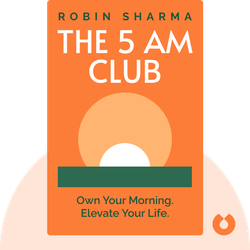Try Blinkist to get the key ideas from 7,000+ bestselling nonfiction titles and podcasts. Listen or read in just 15 minutes.
Start your free trial
Blink 3 of 8 - The 5 AM Club
by Robin Sharma

Strategies of Human Mating
The Evolution of Desire by David M. Buss explores the roots of human desire through evolutionary psychology, uncovering the biological and social factors that shape our romantic and sexual attractions.
Women have long had complex preferences when it comes to choosing mates – preferences that have evolved over time due to changing socioeconomic circumstances.
But let’s start with some basic biology. Women can only reproduce so many times in life, and having a child is a huge commitment that can come with serious consequences. A woman invests her body – along with years of her life – to carry, birth, and nurture just one child.
This makes her extremely valuable to potential mates. But to consider sacrificing her time and her body, women have needed to secure some sort of investment in return – which is often a commitment from her mate.
Centuries ago, it was important for women to have a mate who could ensure their offspring's survivability. This involved both pre-and post-birth factors.
Pre-birth, the health of her potential mate was – and still is – one of the biggest aspects considered. Mating with an unhealthy individual posed a potential threat by exposing the mother and her child to disease. To state the obvious, medicine wasn’t as advanced as it is today, and many children didn’t survive past early childhood. So a mate’s health directly affected the continuation of a bloodline’s reproductive success – the better the genes, the better the chance of survival.
Post-birth factors involved whether the mate was a good provider. Could he provide food and shelter for his family? Would he sacrifice his energy and time into doing so? Finding a reliable provider meant considering multiple characteristics: a man’s physical attributes, social status, athletic skill, emotional stability, and intelligence, among others.
But every woman is unique, and every situation differs. A potential mate who’s extremely valuable to one person might not mean much to another. Some women have focused more on a man’s ability to grow. If he’s reached his peak already, what does he have to offer in the future? Can, and will, he remain committed? Does he have debts or children from previous relationships that will affect his ability to provide?
These preferences weren’t exclusive to Western cultures. They were recognized all across the world, including by cultures that practice polygyny – the practice of having more than one wife.
Many of the same mating preferences have also held true for lesbian women. Throughout history, they’ve looked for good health, kindness, and industriousness in their partners – but have placed a greater importance on honesty and intelligence than heterosexual women.
So how does this psychology of desire relate to modern times, where women can provide for themselves without needing a mate?
Well, Studies show that even when women have access to their own resources and are financially stable, they still prefer a partner who provides some kind of support – whether it’s through money, time, or energy. Human desires are still deeply rooted in our ancestry. We may live in a different environment, but we have the same basic needs and tendencies.
Now it’s time to look at the other end of the spectrum, and analyze the psychology of desire in men.



The Evolution of Desire (1994) drew on the largest study of human mating at the time to analyze the evolutionary foundations that lie behind our everyday desires and mating preferences. It was updated with new material in 2016.
The Evolution of Desire (1994) is a fascinating exploration of the evolutionary roots of human mating behavior. Here's why this book is worth reading:
It's highly addictive to get core insights on personally relevant topics without repetition or triviality. Added to that the apps ability to suggest kindred interests opens up a foundation of knowledge.
Great app. Good selection of book summaries you can read or listen to while commuting. Instead of scrolling through your social media news feed, this is a much better way to spend your spare time in my opinion.
Life changing. The concept of being able to grasp a book's main point in such a short time truly opens multiple opportunities to grow every area of your life at a faster rate.
Great app. Addicting. Perfect for wait times, morning coffee, evening before bed. Extremely well written, thorough, easy to use.
Try Blinkist to get the key ideas from 7,000+ bestselling nonfiction titles and podcasts. Listen or read in just 15 minutes.
Start your free trial
Blink 3 of 8 - The 5 AM Club
by Robin Sharma
What is the main message of The Evolution of Desire?
The main message of The Evolution of Desire is to understand the evolutionary roots of human mating behavior.
How long does it take to read The Evolution of Desire?
The reading time for The Evolution of Desire varies, but our Blinkist summary can be read in just 15 minutes.
Is The Evolution of Desire a good book? Is it worth reading?
The Evolution of Desire is worth reading for its insightful exploration of human mating strategies and evolutionary psychology.
Who is the author of The Evolution of Desire?
The author of The Evolution of Desire is David M. Buss.